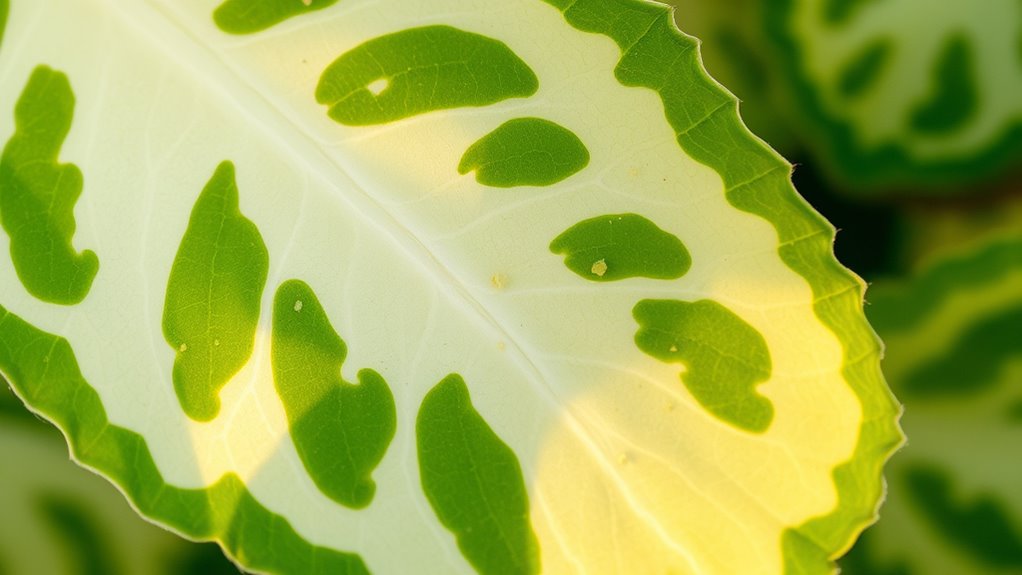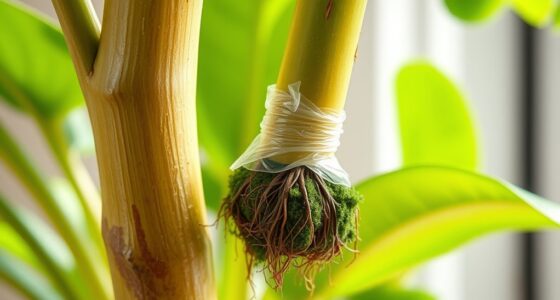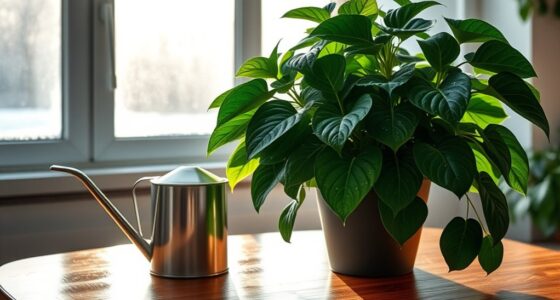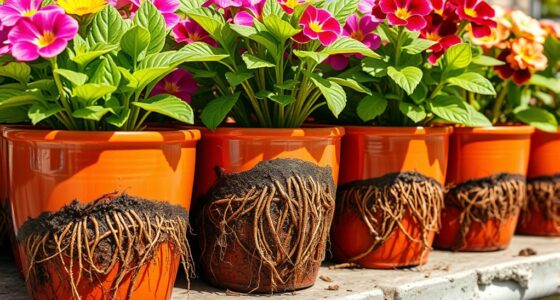Variegation in leaves happens because of genetic factors and environmental conditions. Some plants have mutations or specific genes that cause patches of different colors, like white, yellow, or cream, which can fade or brighten based on light, temperature, and stress. These color changes can be temporary or stable, depending on the plant’s genetics and surroundings. If you want to understand how to influence variegation and why it shifts, there’s more to explore.
Key Takeaways
- Variegation results from genetic mutations affecting chlorophyll production, creating patterned patches of different colors on leaves.
- Environmental factors like light intensity, temperature, and nutrients can influence the visibility and intensity of variegation.
- Loss of variegation may occur due to stress, genetic instability, or environmental changes that reduce chlorophyll in non-green areas.
- Gaining or enhancing variegation can be achieved through selective breeding, cultivation techniques, or optimizing growing conditions.
- The interplay between genetics and environment determines whether leaves maintain, lose, or develop variegated coloration.

Have you ever noticed plants with leaves that display multiple colors or patterns? If so, you’ve seen variegation in action. It’s a fascinating phenomenon where a leaf’s coloration isn’t uniform but instead features patches, streaks, or margins of different shades. This variation can be striking, turning an ordinary plant into a visual masterpiece. But why does this happen? The answer lies in genetics, cell biology, and sometimes environmental influences.
At its core, variegation results from changes in the plant’s ability to produce chlorophyll, the pigment responsible for green coloration. In some parts of the leaf, cells might lack the necessary genes or the proper functioning of chloroplasts, leading to areas that are white, yellow, or cream. These colorless patches don’t contain chlorophyll, so they don’t contribute to photosynthesis. As a result, the plant has to compensate by making more chlorophyll in the green parts, which can sometimes create a striking contrast. The pattern of variegation depends on how these chlorophyll-deficient cells are distributed, which is typically determined by genetic factors.
Variegation arises from genetic changes affecting chlorophyll production and cell distribution patterns in leaves.
Genetics play a vital role here. Many variegated plants are cultivated varieties or cultivars that have been selectively bred for their unique appearance. These plants carry mutations or specific gene combinations that disrupt normal chlorophyll production in certain leaf tissues. Sometimes, these mutations are stable, passed down through generations, making the variegation a permanent trait. Other times, it can be unstable, leading to variegation that appears or disappears unpredictably, especially in response to environmental conditions. Interestingly, biodiversity in cultivated plants can be increased through such selective breeding, contributing to the diversity of plant traits.
Environmental factors can also influence variegation, although they don’t usually cause permanent changes. For example, light levels can enhance or diminish the appearance of variegation. Intense sunlight might intensify the contrast between green and non-green areas, while low light can make the variegation less noticeable. Temperature, nutrient availability, and stress can also play roles in how vibrant or subdued the patterns appear.
In some cases, variegation can be lost over time, especially if the plant undergoes stress or if the genetic mutation is unstable. Conversely, certain cultivation techniques or environmental conditions can encourage the development of more pronounced variegation. Ultimately, whether a plant gains or loses coloration through variegation depends on a complex interplay of genetic makeup and external factors, making it a captivating aspect of plant diversity.
Frequently Asked Questions
Can Variegation Be Inherited Genetically or Is It Caused by Environmental Factors?
Variegation can be inherited genetically, which means it runs in the plant’s DNA and you’ll see it in the offspring. Sometimes, environmental factors like light, temperature, or nutrient levels cause temporary variegation changes, but these aren’t inherited. If you notice consistent variegation in a plant, it’s likely a genetic trait you inherited or that’s been bred into the plant, rather than a temporary environmental effect.
How Do Different Plant Species Vary in Their Variegation Patterns?
You know what they say, “variety is the spice of life,” and it’s true for plant species too. Different plants display unique variegation patterns—some have sharp, defined edges, like a painted border, while others show more diffuse, irregular patches. For example, the striped pattern in variegated schefflera differs from the marbled look of a caladium. Each species’ genetic makeup and environmental factors shape these stunning, diverse appearances.
Is Variegation Always Permanent, or Can It Change Over Time?
Variegation isn’t always permanent; it can change over time. You might notice leaves losing their variegation due to environmental stress, aging, or genetic shifts. Conversely, new growth can sometimes display more vibrant or different patterns. Factors like light, temperature, and care impact these changes. So, if your plant’s variegation shifts, it’s often a natural response or a sign of changing conditions—keeping an eye on those factors helps maintain desired patterns.
What Are the Best Care Practices to Preserve Variegation in Plants?
To preserve variegation, you should give your plant plenty of bright, indirect light, which encourages vibrant leaf color. Avoid direct sunlight, as it can scorch the leaves and cause color loss. Maintain consistent watering and high humidity to reduce stress that might cause variegation to fade. Fertilize with a balanced, diluted fertilizer during the growing season, and keep pests at bay to ensure your plant’s unique foliage stays striking.
Are There Specific Pests or Diseases That Target Variegated Plants More?
Yes, you should watch out for pests like spider mites, aphids, and scale insects, which tend to target variegated plants more. These pests can weaken the plant and cause the variegation to fade or spots to develop. Diseases like fungal infections and leaf spots also pose a threat. Regular inspection, proper watering, and maintaining good air circulation help keep your variegated plants healthy and pest-free.
Conclusion
Now that you understand variegation, you can appreciate how remarkable it is that leaves can change so dramatically. Whether they lose or gain color, it’s like witnessing a living masterpiece constantly in flux. With every leaf, nature proves that its artistry is more breathtaking than the most intricate paintings. So next time your plant’s leaves shift hue, remember—you’re witnessing a wonder that’s truly on the level of a masterpiece crafted by the universe itself.











